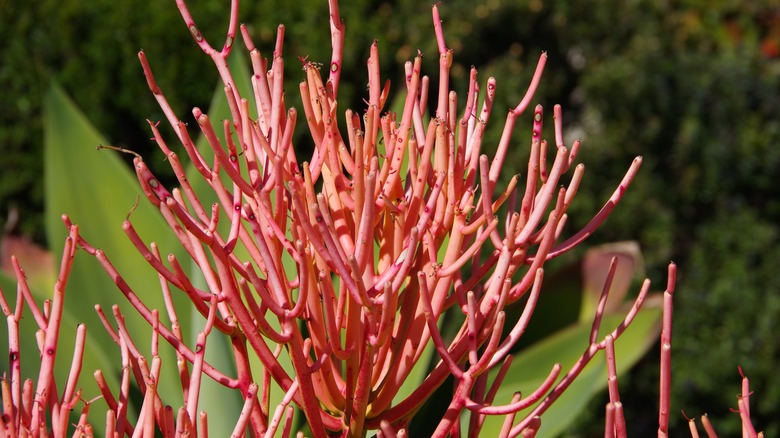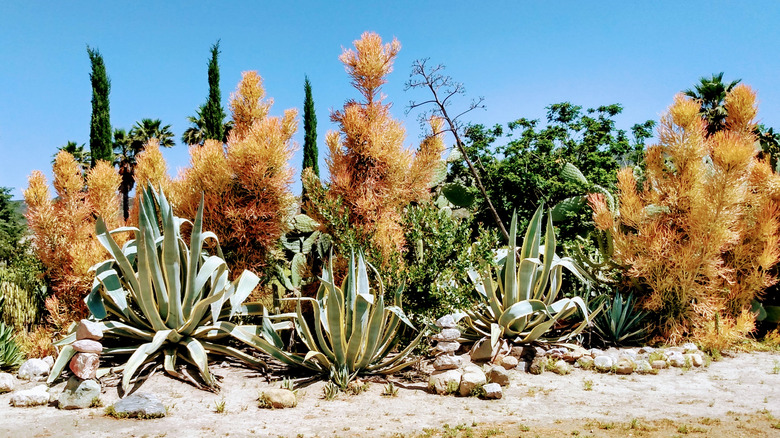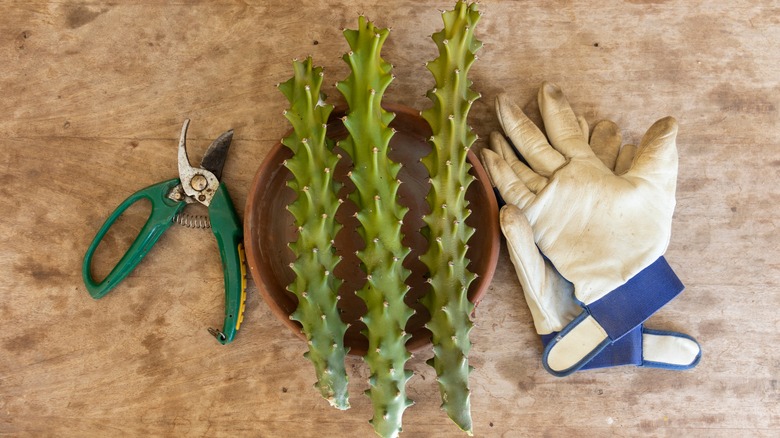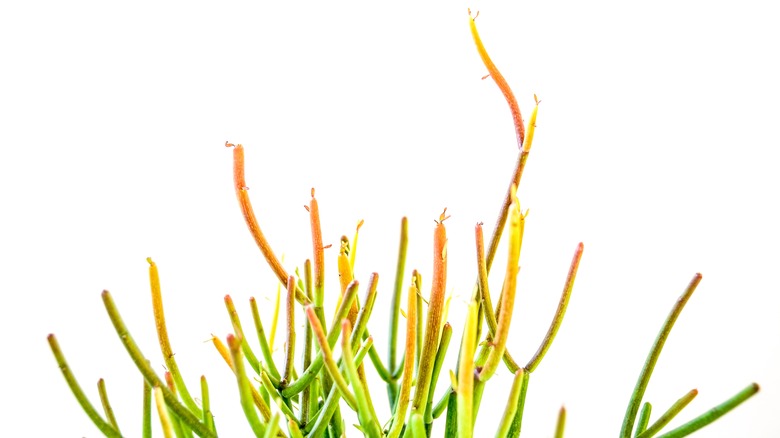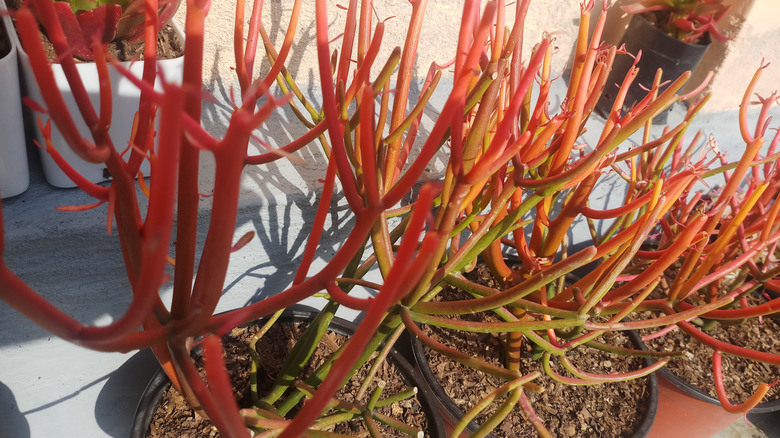How To Care For A Firestick Plant
The firestick plant, also called sticks on fire, is a succulent from the pencil cactus family known as Euphorbia tirucalli. Instead of staying green year-round like other pencil cacti, the stems of the firestick plant turn a bright reddish-orange when overall temperatures drop in cool months. This color distinction is where it gets its full Latin name of Euphorbia tirucalli rosea.
Gardenista explains that just like the many other types of euphorbias, this pencil cactus contains a sap that can immediately irritate skin if touched and can cause serious damage if it gets in your eye. Extreme caution and protective gear, such as gloves and goggles, are recommended when handling this plant.
So long as you can give your sticks on fire a home with lots of direct sun and keep it relatively dry, they will require very little care. These plants can grow up to 30 feet high outdoors. They'll need plenty of space indoors as well, where heights can reach 6 feet.
How to use a firestick plant in garden
The potential for skin and eye irritation may make the firestick plant a less likely choice for a houseplant. However, it is a stunning addition to a garden with its fiery, flame-like stems. Pot it in a large container and use it as a stand alone centerpiece, or keep it untouchable by surrounding it with complementary companion plants.
Unusual Seeds suggests planting a firestick plant with other succulents since they will all prefer the same kind of soil. The firestick stems will outgrow stubbier succulents that flush out closer to the ground, but since firestick stems are thin and grow straight up, they won't block out the light for those below them. For an eye-catching color palette, the vibrant, fiery stems will stand out nicely against subtler greens and dark purples.
In its native central and southern Africa, larger firestick plants are used as boundary fences around farms to deter intruders. There it is commonly called the rubber hedge euphorbia.
How to grow a firestick plant
Per SFGate, firestick branches left on the ground have been known to reseed and grow into thriving new plants on their own. The high success rate of stem cuttings makes it the go-to method for propagation.
Gather your protective wear before cutting a healthy stem. This should include gloves and eye protection. Long sleeve shirts and pants are helpful too. You'll also want a bucket of cold water and a garden hose ready to go. Use sharp shears to cut the stem at the point where it connects to its thicker branch. Then immediately use the water to soak the cutting and wash off the mature plant. This stops the sap from flowing.
The firestick cutting needs to harden. This occurs naturally as it's left to dry and can take up to a week. It's ready to be planted when the cut side becomes callused. Fill a 6-inch pot with cactus specific soil. (Here's a recipe courtesy of The Spruce.) Plant your stem cutting with the cut side down 3 inches into the soil and tamp down. Depending on how long your stem cutting is, it may be prone to leaning. Tiny rocks on top of the soil can help hold it in place. Give your new plant some water and start it in a bright area with indirect sunlight. Over the course of a few weeks, gradually move your baby plant into a spot with direct sun, giving it ample time to acclimate.
How to care for a firestick plant
Hot and arid are the key conditions for a thriving firestick plant. Because they need very high temperatures and almost constant bright sun, these succulents will only grow outdoors in temperate zones of USDA hardiness zones 9 or higher. Anything lower will require a greenhouse or indoor overwintering, which could be a tricky option given how easily it would be to break open a stem and get stung or worse from the irritating sap.
Greenery Unlimited points out that the pencil cactus cannot handle low light for any duration of time (excluding nighttime). So, if you intend to keep yours indoors, place it near the brightest window in the house where it will get the maximum exposure to direct sunlight possible.
Do you travel often or have trouble sticking to a regular watering schedule for your indoor plants? Gardenista makes a strong point for why this potentially harmful plant actually does make a great houseplant option. You can forget about it for quite some time and it will continue to thrive. In fact, because it is prone to root rot and particularly loves desert-like soil, it may be better if you do. So, if you live in a home without pets or small children, or simply have room to keep it out of harm's way, then go ahead and add this interesting blast of color to your décor.
Is the firestick plant toxic?
Your dog may look adorable dressed up in a cactus costume, but be sure to keep her away from the pencil cactus. As already mentioned, the simple answer to the question of toxicity is yes. Firestick pencil cacti are absolutely poisonous to pets (including horses) and humans alike. This goes for all euphorbias, which contain a caustic latex sap in their stems and branches that causes irritation. This can feel like a burning sensation on skin and potentially lead to gastrointestinal upset and vomiting when the toxin is swallowed. People with latex allergies are at a higher risk.
While the ASPCA reports that the plant's actual toxicity level is not as dangerous as it's often made out to be, other sites like the The Cactus King claim that swallowing the sap has led to death in extreme cases. Generally speaking, coming into contact with the sap will cause discomfort and should therefore be avoided.
If you or your pet has gotten sap in your eye, immediately flush it out with running water. When the irritation is localized to skin, the Cactus King recommends applying baking soda which may make it easier to remove the sap and relieve pain. SFGate also recommends rubbing alcohol for sap removal, noting that water alone can make things worse. In the case of your pet consuming a large amount of any part of a firestick plant, get them to a qualified veterinarian or emergency facility as quickly as you can.
How to repot a firestick plant
When it's time to repot your firestick plant, once again, bring on the safety gear. Find a workspace away from children and pets, and consider having that baking soda or rubbing alcohol nearby in case of accidental contact with sap. Remember that you always want to choose a new pot with good drainage, and in the case of the firestick plant, it should be considerably bigger than the old one. SFGate advises going up 2 to 3 inches in both width and depth. Firesticks want that sandy aerated soil, so use a cactus specific mix. Pre-fill the larger pot 1/3 of the way up and move your plant into its new home.
To avoid stem breakage which releases sap, take your time when loosening the plant from its original pot. Hold the base with one hand and use the other to release the pot with a light tap. Once it has been placed in the new pot, all you need to do is fill up any holes with more soil and give it some water.
If you're moving your pencil cactus from a pot to an outdoor spot in your garden, pick a location with lots of room around it. These plants tend to grow about as wide as they do tall. Dig a hole larger than the root ball and take the same care you would going from pot to pot. Finally, consider adding sand to the soil to increase drainage capabilities.
Uses for a firestick plant
According to Research & Reviews: Journal of Pharmacognosy and Phytochemistry, there is medicinal value to be found in the Euphorbia tirucalli. Folklore tales from around the world, particularly from tropical and subtropical regions, describe parts of the plant being used to heal an extensive list of ailments from impotence to toothaches to coughs. But findings tend to be contradictory. For instance, while large doses of its milky latex sap are well known for causing severe gastrointestinal issues, some cultures take small scrapings from firestick roots mixed with coconut oil to actually cure a stomachache.
Another unexpected use of the firestick plant is oil for fuel. A recent Science Direct article explains how the stem bark can yield oil that can be turned into liquid biofuel and used as an alternative to fossil fuels for powering engines. This is particularly beneficial in countries like Tanzania where most of the commonly used plants for biofuel are needed as food crops to feed people instead. Experimentation with the oil from the firestick plant is gaining credibility and providing a hopeful solution for organic options of crude oil for gasoline.
